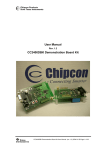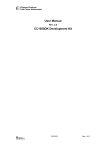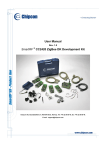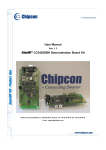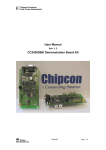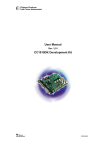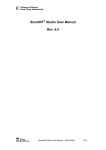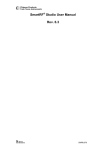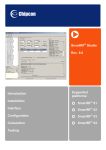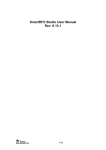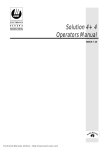Download Datasheet
Transcript
User Manual Rev. 2.0 CC1020/1070DK Development Kit SWRU052 Table of Contents: INTRODUCTION ....................................................................................................................... 3 CC1020/1070DK DEVELOPMENT KIT CONTENTS............................................................... 4 CC1020EB EVALUATION BOARD.......................................................................................... 5 DESCRIPTION ........................................................................................................................... 5 VOLTAGE SUPPLY ..................................................................................................................... 5 PC-INTERFACE ......................................................................................................................... 5 CC1020EB SCHEMATICS ......................................................................................................... 6 CC1020EB BILL OF MATERIALS ............................................................................................... 9 CC1020EB LAYOUT .............................................................................................................. 12 CC1020EMX AND CC1070EM EVALUATION MODULES ................................................... 13 DESCRIPTION ......................................................................................................................... 13 CC1020EMX-433 SCHEMATIC .............................................................................................. 18 CC1020EMX-433 BILL OF MATERIALS ................................................................................... 19 CC1020EMX-868/915 SCHEMATIC ....................................................................................... 21 CC1020EMX-868/915 BILL OF MATERIALS ............................................................................ 22 CC1020EMX ASSEMBLY DRAWINGS ...................................................................................... 24 CC1020EMX LAYOUT ........................................................................................................... 24 CC1070EM-433 SCHEMATIC ................................................................................................. 25 CC1070EM-433 BILL OF MATERIALS ..................................................................................... 26 CC1070EM-868/915 SCHEMATIC .......................................................................................... 27 CC1070EM-868/915 BILL OF MATERIALS ............................................................................... 28 C1070EM ASSEMBLY DRAWINGS ........................................................................................... 29 CC1070EM LAYOUT .............................................................................................................. 29 USING THE CC1020/1070DK DEVELOPMENT KIT ............................................................. 30 HOW TO SET UP A TRANSMITTER (CC1020 AND CC1070)........................................................ 30 HOW TO SET UP A RECEIVER (CC1020)................................................................................... 30 GENERAL INFORMATION..................................................................................................... 32 ADDRESS INFORMATION..................................................................................................... 33 SWRU052 Page 2 of 33 Introduction The CC1020 single chip transceiver and the CC1070 single chip transmitter provide extensive features and great flexibility, which make the chips suitable for a very large number of applications and system requirements. The CC1020 and CC1070 are especially suited for narrowband systems. The CC1020/1070DK development kit is primarily designed to make it easy for designers to evaluate transceiver and transmitter performance and in a minimum of time develop their own applications. The CC1020/1070DK development kit includes two CC1020EB evaluation boards, two CC1020EMX evaluation modules and one CC1070EM evaluation module. The CC1020EMX includes the CC1020 transceiver chip with the external components necessary for operation. The CC1070EM includes the CC1070 transmitter chip with the external components necessary for operation. The evaluation modules are mounted onto the CC1020EB, which is equipped with a voltage regulator and a PC interface circuitry. Using the CC1020EB connected to a PC running the SmartRF® Studio software, various CC1020 and CC1070 system parameters can be changed and tested. Technical features: CC1020 : - RF output power up to +10/+5 dBm programmable in 1 dB steps at 433/868 MHz respectively - High sensitivity (up to –121 dBm for a 12.5 kHz channel) - Low Adjacent Channel Power (ACP) - High Adjacent Channel Rejection (ACR) - Integrated bit synchronizer - Image rejection mixer - Automatic Frequency Control which reduces the crystal accuracy requirement - Digital RSSI and carrier sense indicator CC1070 : - RF output power up to +10/+8 dBm programmable in 1 dB steps at 433/868 MHz respectively - Low Adjacent Channel Power (ACP) This user manual describes how to get started with the CC1020/1070DK development kit. You will also find description on the CC1020EB, CC1020EMX, CC1070EM and advice on how to develop your own applications. For details on CC1020 and CC1070 please refer to the corresponding data sheet. For details on how to use the SmartRF® Studio software please refer to the SmartRF® Studio user manual. SWRU052 Page 3 of 33 CC1020/1070DK Development Kit Contents Your SmartRF® CC1020/1070DK development kit should contain the following items: Item Quantity Comment CC1020EB evaluation board 2 CC1020EMX evaluation module 2 CC1070EM evaluation module 1 PC parallel port extension cable 2 Adapter 6 25-pin D-sub, male-female, 3 m Antenna 2 SMA male- BNC female CC1020 samples 5 50Ω, λ/4 monopole, SMA male CC1070 samples 5 CC1020/1070 Quick Start User Manual 1 SWRU052 Page 4 of 33 CC1020EB Evaluation Board The CC1020EB evaluation board includes the following items: • 4-10 V to 3 V voltage regulator • Possibility to apply a 3 V voltage source directly (chosen by the switch on the board) • Voltage-level interface circuitry between the CC1020 or CC1070 chip (3 V) and the parallel port of the computer (5 V) • Connector for a PC parallel port cable • Connectors for modulation data in/out and synchronisation clock output • 2 x 10 female connectors for connection to CC1020 or CC1070 evaluation module (described later) Description The CC1020EB constitutes of three main parts. These are the sockets for the evaluation module (RF-section), the voltage supply and the PC-interface. The CC1020EB includes a number of components for maximum flexibility. However, only a minor part of these components are required in an actual application. Check the CC1020 and CC1070 datasheets for typical application circuits. Voltage supply The user can choose between applying a 4-10 V non-regulated supply voltage or a 3 V regulated supply voltage by setting a switch on the board (SPDT). If a non-regulated supply voltage is applied, an on board regulator generates a regulated 3 V supply. A diode prevents damage if the wrong polarity is used for the non-regulated input. The connector has five contacts as shown in Figure 1. In addition to the three supply voltage contacts, there are two contacts, which can be used to measure the CC1020 or CC1070 DC current. A short jumper is placed between these two contacts for the circuit to work in the default configuration. If you want to measure the DC current, replace the jumper with an ampere meter as shown in Figure 1. 4-10 V GND 3V I_OUT A I_IN Figure 1: The voltage supply connector with an ampere meter attached Important: For narrowband applications phase noise is a critical parameter. Make sure your voltage supply has sufficiently low noise performance so as not to degrade your measurements. PC-interface The PC-interface is a 5-to/from-3 V level shift circuit, which buffers all control lines. The various CC1020 and CC1070 system parameters can be changed through the PC interface by running the SmartRF® Studio software. SWRU052 Page 5 of 33 CC1020EB Schematics Figure 2. CC1020EB top level schematic SWRU052 Page 6 of 33 Figure 3. CC1020EB voltage regulator schematic SWRU052 Page 7 of 33 Figure 4. CC1020EB PC interface schematic SWRU052 Page 8 of 33 CC1020EB Bill of Materials Voltage regulator Reference Description Value Part C4 Capacitor 1206 2.2 uF C_2U2_1206_X7R_K_10 C5 Capacitor 1206 2.2 uF C_2U2_1206_X7R_K_10 C6 Capacitor 0603 10 nF C_10N_0603_X7R_K_50 C7 Capacitor low ESR Not used R3 Resistor 0603 Not used R30 Resistor 0603 Not used R31 Resistor 0603 Not used D1 Diode, Si BAT254 S1 SPDT switch SWITCH_SPDT U1 Voltage regulator LP2985, 3V, National Semiconductor PC interface Reference Description Value Part C8 Capacitor 0603 33 nF C_33N_0603 _X7R_K_25 C9 Capacitor 0603 33 nF C_33N_0603 _X7R_K_25 Q1 BJT, Si, NPN, small signal BC846 Q2 BJT, Si, NPN, small signal BC846 Q3 BJT, Si, NPN, small signal BC846 Q4 BJT, Si, NPN, small signal BC846 Q5 BJT, Si, NPN, small signal BC846 R4 Resistor 0603 10 kΩ R_10K_0603_G R5 Resistor 0603 10 kΩ R_10K_0603_G R6 Resistor 0603 10 kΩ R_10K_0603_G R7 Resistor 0603 10 kΩ R_10K_0603_G R8 Resistor 0603 10 kΩ R_10K_0603_G R9 Resistor 0603 10 kΩ R_10K_0603_G R10 Resistor 0603 10 kΩ R_10K_0603_G R11 Resistor 0603 10 kΩ R_10K_0603_G R12 Resistor 0603 10 kΩ R_10K_0603_G R13 Resistor 0603 10 kΩ R_10K_0603_G R14 Resistor 0603 10 kΩ R_10K_0603_G R15 Resistor 0603 10 kΩ R_10K_0603_G R16 Resistor 0603 10 kΩ R_10K_0603_G R17 Resistor 0603 10 kΩ R_10K_0603_G R18 Resistor 0603 10 kΩ R_10K_0603_G R19 Resistor 0603 10 kΩ R_10K_0603_G R20 Resistor 0603 10 kΩ R_10K_0603_G R21 Resistor 0603 10 kΩ R_10K_0603_G R22 Resistor 0603 10 kΩ R_10K_0603_G SWRU052 Page 9 of 33 R23 Resistor 0603 10 kΩ R_10K_0603_G R24 Resistor 0603 100 kΩ R_100K_0603_G R25 Resistor 0603 100 kΩ R_100K_0603_G R26 Resistor 0603 100 kΩ R_100K_0603_G R27 Resistor 0603 100 kΩ R_100K_0603_G R28 Resistor 0603 100 kΩ R_100K_0603_G R29 Resistor 0603 Not used U2 Hex inverter, oc 74HC05 U3 Hex inverter, oc 74HC05 Evaluation board Reference Description Value Part C1 Capacitor 1206 2.2 uF C_2U2_1206_X7R_K_10 C2 Capacitor 0603 220 pF C_220P_0603_NP0_G_50 C3 Capacitor 0603 33 nF C_33N_0603_X7R_K_25 R1 Resistor 0603 470 Ω R_470_0603_J R2 Resistor 0603 470 Ω R_470_0603_J D2 LED, green, SMD LED_CL150GCD D3 LED, yellow, SMD LED_CL150YCD H1 Circuit Board Support H2 Circuit Board Support H3 Circuit Board Support H4 Circuit Board Support P1 D-Sub, 25 pin DSUB_25 P2 5 pin terminal, screw SCREW_TERM_5 P3 Connector, 0.9mm pin female CONN10_FEMALE P4 Connector, 0.9mm pin female CONN10_FEMALE P5 SMA connector SMA_RA (Right angle) P6 SMA connector SMA_RA (Right angle) P7 Pinrow, 2x5 PINROW_2X5 SWRU052 Page 10 of 33 CC1020EB Assembly Drawing Figure 5. CC1020EB PCB assembly drawing SWRU052 Page 11 of 33 CC1020EB Layout Figure 6. CC1020EB PCB layout. Layer 1 (top) and Layer 2 (bottom) SWRU052 Page 12 of 33 CC1020EMX and CC1070EM Evaluation Modules The CC1020EMX evaluation module includes the following items: • A SmartRF® CC1020 transceiver chip • Antenna input/output matching network • Connector for antenna (50 Ω SMA) • 2 x 10 male connectors for connection to CC1020EB evaluation board The CC1020EMX is distributed in two versions, 433 MHz and 868/915 MHz, and the difference is the frequency band of operation. The operating frequency band is marked on the CC1020EMX evaluation module. • The 433 MHz CC1020EMX-433 evaluation module is optimised for 12.5/25 kHz channel spacing • The 868/915 MHz CC1020EMX-868 evaluation module is optimised for 25 kHz channel spacing The CC1070EM evaluation module includes the following items: • A SmartRF® CC1070 transmitter chip • Antenna output matching network • Connector for antenna (50 Ω SMA) • 2 x 10 male connectors for connection to CC1020EB evaluation board The CC1070EM is distributed in two versions, 433 MHz and 868/915 MHz, and the difference is the frequency band of operation. The operating frequency band is marked on the CC1070EM evaluation module. • The 433 MHz CC1070EM-433 evaluation module is optimised for 12.5/25 kHz channel spacing. • The 868/915 MHz CC1070EM-868 evaluation module is optimised for 25 kHz channel spacing. Description The CC1020EMX evaluation module consists of a CC1020 transceiver chip with external components. The CC1070EM evaluation module consists of a CC1070 transmitter chip with external components. The different components are explained below. The loop filter The loop filter consists of two resistors (R2 and R3) and three capacitors (C6-C8). C7 and C8 may be omitted in applications where high loop bandwidth is desired. The values mounted on the CC1020EMX and CC1070EM can be used for data rates up to 4.8 kBaud. For higher data rates use the component values calculated in the SmartRF® Studio software program or use the values given in Table 1. SWRU052 Page 13 of 33 Data rate Deviation (kBaud) (kHz) Up to 4.8 C6 C7 C8 R2 R3 (nF) (pF) (pF) (kΩ) (kΩ) 220 8200 2200 1.5 4.7 12.5 kHz channel spacing 100 3900 1000 2.2 6.8 25 kHz channel spacing Up to ±2.4 9.6 ±4.8 56 2200 560 3.3 10 19.2 ±9.6 15 560 150 5.6 18 38.4 ±19.2 3.9 120 33 12 39 76.8 ±38.4 1.0 27 3.3 27 82 153.6 ±76.8 0.2 1.5 - 47 150 Comment Table 1. PLL loop filter component values for different data rates Bias resistor The precision bias resistor R1 is used to set an accurate bias current. The LOCK signal A LOCK signal is connected to the PC parallel port interface to be monitored by the SmartRF® Studio software. The signal tells you when the synthesiser frequency is in lock. It is also available at a test pin and is active low. This digital output can also be configured to other functions. Please refer to the CC1020 and CC1070 data sheets for details. Input/output matching and filtering The CC1020 input/output matching network and the CC1070 output matching network are optimised for either 433 MHz or 868 MHz operation. • The CC1020 input/output matching network consists of L1, L2, C1 and C3 (see Figure 11 and Figure 12) • The CC1070 output matching network consists of L2, C2 and C3 (see Figure 15 and Figure 16) The component values are calculated in the SmartRF® Studio software program. Using the specified matching network component values gives an optimum match at the specified operating frequency. Minor tuning of the component values may be necessary to compensate for layout parasitics at other frequencies or other PCB layouts. The crystal oscillator The crystal frequency is 14.7456 MHz. The crystal oscillator, X1, circuit has a trimmer capacitor, CT1, which reduces the initial tolerance of the crystal to zero by careful adjustment using a precision frequency counter. The crystal used has ±10 ppm accuracy and changes ±10 ppm over the –10 to +60 °C temperature range. The loading capacitors (C4 and C5) are designed for a 16 pF crystal load. It is also possible to use an external clock signal. Be sure to remove the crystal if an external clock is used. When using a low amplitude sine wave (300 mVpp) as external clock signal the signal must be connected to XOSC_Q1 using a DC block (10 nF). Set XOSC_BYPASS=’0’ in the INTERFACE register. A full-swing digital external clock can also be used. In this case set XOSC_BYPASS=’1’ and do not use a DC block capacitor. SWRU052 Page 14 of 33 LC filter An LC-filter attenuates the spurious emission in transmit mode. • For CC1020 at 433 MHz the LC filter is a T-type filter topology (L70, L71 and C72) in Figure 11 • For CC1020 at 868 MHz the LC filter is a π-type filter topology (C71, C72 and L70) in Figure 12 • For CC1070 the LC filter is a T-type filter topology for both 433 MHz and 868/915 MHz (L71, L72 and C71) in Figure 15 and Figure 16 Power supply decoupling and filtering Power supply decoupling and filtering must be used. The placement and size of the decoupling capacitors and the power supply filtering are very important to achieve the best performance for narrowband applications. The CC1020EMX and CC1070EM evaluation modules should be used as reference designs and should be followed very closely. The PCB Gerber-files are available from the Chipcon web site (http://www.chipcon.com ). LNA_EN and PA_EN CC1020 has two digital output pins, PA_EN and LNA_EN, which can be used to control an external LNA, PA or an external Rx/Tx switch. Both PA_EN and LNA_EN are used to control the external Rx/Tx switch on the CC1020EMX. These outputs can also be used as general digital output control signals. Please see the CC1020 data sheet for details. PA_EN and LNA_EN are connected to two LEDs on the CC1020EB. In order to utilize this option, two 0 Ω resistors, R25 and R26, must be soldered onto the CC1020EMX. CC1070 has one digital output pin, PA_EN, which can be used to control an external PA. This output can also be used as general digital output control signals. Please see the CC1070 data sheet for details. PA_EN is connected to a LED on the CC102EB. In order to utilize this option, a 0 Ω resistor, R25, must be soldered onto the CC1070EM. The configuration interface The microcontroller uses 3 or 4 I/O pins for the configuration interface (PDI, PDO, PCLK and PSEL). PDO should be connected to an input at the microcontroller. PDI, PCLK and PSEL must be microcontroller outputs. One I/O pin can be saved if PDI and PDO are connected together and a bi-directional pin is used at the microcontroller. Please see the CC1020 and CC1070 data sheets for details. In the CC1020/1070DK all configuration data is initialised by the SmartRF® Studio software. DIO and DCLK The modulation input/output (DIO for CC1020 and DI for CC1070) and the data clock (DCLK) are connected to separate connectors. The connectors are of type SMA female. The CC1020 and CC1070 can be used with NRZ (Non-Return-to-Zero) data or Manchester (also known as bi-phase-level) encoded data. CC1020 can also synchronize the data from the demodulator and provide the data clock at DCLK. CC1020 and CC1070 can be configured for three different data formats: Synchronous NRZ mode: In transmit mode CC1020 and CC1070 provide the data clock at DCLK, and DIO (DI) is used as data input. Data is clocked into CC1020 and CC1070 at the rising edge of DCLK. The data is modulated at RF without encoding. In receive mode CC1020 performs the synchronization and provides the received data clock at DCLK and data at DIO. The data should be clocked into the interfacing circuit at the rising SWRU052 Page 15 of 33 edge of DCLK as shown in Figure 7. As an option the LOCK pin can be used as data output in this mode during reception. Please see the CC1020 data sheet for further details. Synchronous Manchester encoded mode: In transmit mode CC1020 and CC1070 provide the data clock at DCLK, and DIO (DI) is used as data input. Data is clocked into CC1020 and CC1070 at the rising edge of DCLK and should be in NRZ format. The data is modulated at RF with Manchester code. The encoding is done by CC1020 and CC1070. In this mode the effective bit rate is half the baud rate due to the coding. In receive mode CC1020 performs the synchronization and provides received data clock at DCLK and data at DIO. CC1020 does the decoding and NRZ data is presented at DIO. The data should be clocked into the interfacing circuit at the rising edge of DCLK as shown in Figure 8. As an option the LOCK pin can be used as data output in this mode during reception. Please see the CC1020 data sheet for further details. Transparent Asynchronous UART mode: In transmit mode CC1020 and CC1070 use DIO (DI) as data input. The data is modulated at RF without synchronization or encoding. With CC1020 in receive mode the raw data signal from the demodulator is sent to the output (DIO). No synchronization or decoding of the signal is performed in CC1020 and should be done by the interfacing circuit. As an option the DCLK pin can be used as data output in this mode during reception. See Figure 9. Please see the CC1020 data sheet for further details. Manchester encoding and decoding: In the Synchronous Manchester encoded mode CC1020 and CC1070 use Manchester coding when modulating the data. The CC1020 also performs the data decoding and synchronization. The Manchester coding is based on transitions; a “0” is encoded as a low-tohigh transition, a “1” is encoded as a high-to-low transition. See Figure 10. The Manchester coding ensures that the signal has a constant DC component, which is necessary in some FSK demodulators. Using this mode also ensures compatibility with the CC400/CC900 designs. Transmitter side: DCLK Clock provided by CC1020/CC1070 DIO/DI Data provided by microcontroller “RF” FSK modulating signal (NRZ), internal in CC1020/CC1070 Receiver side: “RF” Demodulated signal (NRZ), internal in CC1020 DCLK Clock provided by CC1020 DIO Data provided by CC1020 Figure 7. Synchronous NRZ mode SWRU052 Page 16 of 33 Transmitter side: DCLK Clock provided by CC1020/CC1070 DIO/DI Data provided by microcontroller “RF” FSK modulating signal (Manchester encoded), internal in CC1020/CC1070 Receiver side: “RF” Demodulated signal (Manchester encoded), internal in CC1020 DCLK Clock provided by CC1020 DIO Data provided by CC1020 Figure 8. Synchronous Manchester encoded mode Transmitter side: DCLK is not used in transmit mode, and is used as data output in receive mode. It can be set to default high or low in transmit mode. DCLK DIO/DI Data provided by UART (TXD) “RF” FSK modulating signal, internal in CC1020/CC1070 Receiver side: “RF” Demodulated signal (NRZ), internal in CC1020 DCLK DCLK is used as data output provided by CC1020. Connect to UART (RXD) DIO is not used in receive mode. Used only as data input in transmit mode DIO Figure 9. Transparent Asynchronous UART mode 1 0 1 1 0 0 0 1 1 0 1 Time Figure 10. Manchester encoding SWRU052 Page 17 of 33 CC1020EMX-433 Schematic Figure 11. CC1020EMX-433 MHz schematic SWRU052 Page 18 of 33 CC1020EMX-433 Bill of Materials RF part 433 MHz Reference Description Value Part C1 Capacitor 0402 10 pF C_10P_0402_NP0_J_50 C2 Capacitor 0402 C3 Capacitor 0402 5.6 pF Not used C_5P6_0402_NP0_J_50 C4 Capacitor 0402 22 pF C_22P_0402_NP0_J_50 C5 Capacitor 0402 12 pF C_12P_0402_NP0_J_50 C6 Capacitor 0603 220 nF C_220N_0603_X7R_K_50 C7 Capacitor 0402 8.2 nF C_8N2_0402_X7R_K_25 C8 Capacitor 0402 2.2 nF C_2N2_0402_X7R_K_25 C10 Capacitor 1206 10 uF C_10U_1206_X7R_M_6P3 C12 Capacitor 0402 220 pF C_220P_0402_NP0_J_50 C36 Capacitor 0402 68 pF C_68P_0402_NP0_J_50 C38 Capacitor 0402 1 nF C_1N_0402_X7R_K_50 C39 Capacitor 0402 220 pF C_220P_0402_NP0_J_50 C40 Capacitor 0402 12 pF C_12P_0402_NP0_J_50 C41 Capacitor 0402 10 nF C_10N_0402_X7R_K_25 C46 Capacitor 0402 68 pF C_68P_0402_NP0_J_50 C47 Capacitor 0402 33 pF C_33P_0402_NP0_J_50 C52 Capacitor 0402 150 pF C_150P_0402_NP0_J_50 C60 Capacitor 0402 220 pF C71 Capacitor 0402 C72 Capacitor 0402 4.7 pF C80 Capacitor 1206 2.2 uF C_2U2_1206_X7R_K_10 C81 Capacitor 0402 33 nF C_33N_0402_X7R_K_25 C90 Capacitor 0402 1 nF C_1N_0402_X7R_K_50 C94 Capacitor 0402 1 nF C_1N_0402_X7R_K_50 CT1 Trimmer Capacitor L1 Inductor 0402 33 nH L_33N_0402_J L2 Inductor 0402 22 nH L_22N_0402_J C_220P_0402_NP0_J_50 Not used C_4P7_0402_NP0_J_50 C_3-10P_TRIM_NP0 L21 EMI filter bead L21 Inductor 0402 1.2 nH L_1N2_0402_S L_BEAD_102_0603 L70 Inductor 0402 47 nH L_47N_0402_J L71 Inductor 0402 39 nH L_39N_0402_J P2 Surface-mount SMA, straight SMA_SMD P3 Connector, 0.9mm pin, male CONN10_MALE P4 Connector, 0.9mm pin, male CONN10_MALE R1 Resistor 0402 82 kΩ R_82K_0402_F R2 Resistor 0402 1.5 kΩ R_1K5_0402_G R3 Resistor 0402 4.7 kΩ R_4K7_0402_G R4 Resistor 0402 1 kΩ R_1K0_0402_J R5 Resistor 0402 1 kΩ R_1K0_0402_J R8 Resistor 0402 33 Ω R_33_0402_G R10 Resistor 0402 82 Ω R25 Resistor 0402 R_82_0402_G Not used SWRU052 Page 19 of 33 R26 Resistor 0402 Not used U1 Single chip transceiver CC1020 U2 GaAs SPDT switch, DC – 3.0 GHz SW_456 X1 Crystal, HC-49-SMD X14.7456/10/10/10/16 SWRU052 Page 20 of 33 CC1020EMX-868/915 Schematic Figure 12. CC1020EMX-868/915 MHz schematic SWRU052 Page 21 of 33 CC1020EMX-868/915 Bill of Materials RF part 868 MHz Reference Description Value Part C1 Capacitor 0402 47 pF C_47P_0402_NP0_J_50 C2 Capacitor 0402 C3 Capacitor 0402 10 pF Not used C_10P_0402_NP0_J_50 C4 Capacitor 0402 22 pF C_22P_0402_NP0_J_50 C5 Capacitor 0402 12 pF C_12P_0402_NP0_J_50 C6 Capacitor 0603 100 nF C_100N_0603_X7R_K_50 C7 Capacitor 0402 3.9 nF C_3N9_0402_X7R_K_25 C8 Capacitor 0402 1 nF C_1N_0402_X7R_K_50 C10 Capacitor 1206 10 uF C_10U_1206_X7R_M_6P3 C12 Capacitor 0402 220 pF C_220P_0402_NP0_J_50 C36 Capacitor 0402 68 pF C_68P_0402_NP0_J_50 C38 Capacitor 0402 1 nF C_1N0_0402_X7R_K_50 C39 Capacitor 0402 47 pF C_47P_0402_NP0_J_50 C40 Capacitor 0402 12 pF C_12P_0402_NP0_J_50 C41 Capacitor 0402 270 pF C_270P_0402_NP0_J_50 C46 Capacitor 0402 68 pF C_68P_0402_NP0_J_50 C47 Capacitor 0402 5.6 pF C_5P6_0402_NP0_J_50 C52 Capacitor 0402 47 pF C_47P_0402_NP0_J_50 C60 Capacitor 0402 220 pF C_220P_0402_NP0_J_50 C71 Capacitor 0402 8.2 pF C_8P2_0402_NP0_J_50 C72 Capacitor 0402 8.2 pF C_8P2_0402_NP0_J_50 C80 Capacitor 1206 2.2 uF C_2U2_1206_X7R_K_10 C81 Capacitor 0402 33 nF C_33N_0402_X7R_K_25 C90 Capacitor 0402 1 nF C_1N_0402_X7R_K_50 C94 Capacitor 0402 1 nF C_1N_0402_X7R_K_50 CT1 Trimmer Capacitor L1 Inductor 0402 82 nH L_82N_0402_J L2 Inductor 0402 3.6 nH L_3N6_0402_J C_3-10P_TRIM_NP0 L21 EMI filter bead L22 Inductor 0402 2.2 nH L_BEAD_102_0603 L_2N2_0402_J L70 Inductor 0402 5.1 nH L_5N1_0402_J L71 Resistor 0402 0Ω R_0_0402 P2 Surface-mount SMA, straight SMA_SMD P3 Connector, 0.9mm pin, male CONN10_MALE P4 Connector, 0.9mm pin, male CONN10_MALE R1 Resistor 0402 82 kΩ R_82K_0402_F R2 Resistor 0402 2.2 kΩ R_2K2_0402_G R3 Resistor 0402 6.8 kΩ R_6K8_0402_G R4 Resistor 0402 1 kΩ R_1K0_0402_J R5 Resistor 0402 1 kΩ R_1K0_0402_J R8 Resistor 0402 33 Ω R_33_0402_G R10 Resistor 0402 82 Ω R25 Resistor 0402 R_82_0402_G Not used SWRU052 Page 22 of 33 R26 Resistor 0402 Not used U1 Single chip transceiver CC1020 U2 GaAs SPDT switch, DC – 3.0 GHz SW_456 X1 Crystal, HC-49-SMD X14.7456/10/10/10/16 SWRU052 Page 23 of 33 CC1020EMX Assembly Drawings Figure 13. CC1020EMX PCB top level assembly drawing CC1020EMX Layout Figure 14. CC1020EMX PCB layout. Layer 1 (top) and Layer 2 (bottom) SWRU052 Page 24 of 33 CC1070EM-433 Schematic Figure 15. CC1070EM-433 MHz schematic SWRU052 Page 25 of 33 CC1070EM-433 Bill of Materials RF part 433 MHz Reference Description Value Part C2 Capacitor 0402 2.2 pF C_2P2_0402_NP0_C_50 C3 Capacitor 0402 5.6 pF C_5P6_0402_NP0_J_50 C4 Capacitor 0402 22 pF C_22P_0402_NP0_J_50 C5 Capacitor 0402 12 pF C_12P_0402_NP0_J_50 C6 Capacitor 0603 220 nF C_220N_0603_X7R_K_50 C7 Capacitor 0402 8.2 nF C_8N2_0402_X7R_K_25 C8 Capacitor 0402 2.2 nF C_2N2_0402_X7R_K_25 C10 Capacitor 1206 10 uF C_10U_1206_X7R_M_6P3 C38 Capacitor 0402 1 nF C_1N_0402_X7R_K_50 C41 Capacitor 0402 47 pF C_47P_0402_NP0_J_50 C42 Capacitor 0402 68 pF C_68P_0402_NP0_J_50 C46 Capacitor 0402 68 pF C_68P_0402_NP0_J_50 C60 Capacitor 0402 220 pF C_220P_0402_X7R_K_50 C71 Capacitor 0402 4.7 pF C_4P7_0402_NP0_J_50 C80 Capacitor 1206 2.2 uF C_2U2_1206_X7R_K_10 C81 Capacitor 0402 33 nF C_33N_0402_X7R_K_25 C92 Capacitor 0402 10 nF C_10N_0402_X7R_K_25 C93 Capacitor 0402 10 nF C_10N_0402_X7R_K_25 CT1 Trimmer Capacitor L2 Inductor 0402 22 nF L_22N_0402_J L71 Inductor 0402 47 nF L_47N_0402_J L72 Inductor 0402 47 nF L_47N_0402_J P2 Surface-mount SMA, straight SMA_SMD P3 Connector, 0.9mm pin, male CONN10_MALE P4 Connector, 0.9mm pin, male CONN10_MALE R1 Resistor 0402 82 kΩ R_82K_0402_F R2 Resistor 0402 1.5 kΩ R_1K5_0402_G R3 Resistor 0402 4.7 kΩ R_4K7_0402_G R6 Resistor 0402 82 Ω R_82_0402_G R8 Resistor 0402 33 Ω R_33_0402_G R25 Resistor 0402 Not used U3 Single chip transmitter CC1070 X1 Crystal, HC-49-SMD X14.7456/10/10/10/16 C_3-10P_TRIM_NP0 SWRU052 Page 26 of 33 CC1070EM-868/915 schematic Figure 16. CC1070EM-868/915 MHz schematic SWRU052 Page 27 of 33 CC1070EM-868/915 bill of materials RF part 868 MHz Reference Description Value Part C2 Capacitor 0402 1.5 pF C_1P5_0402_NP0_C_50 C3 Capacitor 0402 10 pF C_10P_0402_NP0_J_50 C4 Capacitor 0402 22 pF C_22P_0402_NP0_J_50 C5 Capacitor 0402 12 pF C_12P_0402_NP0_J_50 C6 Capacitor 0603 100 nF C_100N_0603_X7R_K_50 C7 Capacitor 0402 3.9 nF C_3N9_0402_X7R_K_25 C8 Capacitor 0402 1 nF C_1N_0402_X7R_K_50 C10 Capacitor 1206 10 uF C_10U_1206_X7R_M_6P3 C38 Capacitor 0402 1 nF C_1N_0402_X7R_K_50 C41 Capacitor 0402 680 pF C_680P_0402_X7R_K_50 C42 Capacitor 0402 68 pF C_68P_0402_NP0_J_50 C46 Capacitor 0402 68 pF C_68P_0402_NP0_J_50 C60 Capacitor 0402 220 pF C_220P_0402_X7R_K_50 C71 Capacitor 0402 3.3 pF C_3P3_0402_NP0_J_50 C80 Capacitor 1206 2.2 uF C_2U2_1206_X7R_K_10 C81 Capacitor 0402 33 nF C_33N_0402_X7R_K_25 C92 Capacitor 0402 10 nF C_10N_0402_X7R_K_25 C93 Capacitor 0402 10 nF C_10N_0402_X7R_K_25 CT1 Trimmer Capacitor L2 Inductor 0402 6.8 nH L_6N8_0402_J L71 Inductor 0402 12 nH L_12N_0402_J L72 Inductor 0402 12 nH L_12N_0402_J P2 Surface-mount SMA, straight SMA_SMD P3 Connector, 0.9mm pin, male CONN10_MALE P4 Connector, 0.9mm pin, male CONN10_MALE R1 Resistor 0402 82 kΩ R_82K_0402_F R2 Resistor 0402 2.2 kΩ R_2K2_0402_G R3 Resistor 0402 6.8 kΩ R_6K8_0402_G R6 Resistor 0402 82 Ω R_82_0402_G R8 Resistor 0402 33 Ω R_33_0402_G R25 Resistor 0402 Not used U3 Single chip transmitter CC1070 X1 Crystal, HC-49-SMD X14.7456/10/10/10/16 C_3-10P_TRIM_NP0 SWRU052 Page 28 of 33 C1070EM Assembly Drawings Figure 17. CC1070EM PCB top level assembly drawing CC1070EM Layout Figure 18. CC1070EM PCB layout. Layer 1 (top) and Layer 2 (bottom) SWRU052 Page 29 of 33 Using the CC1020/1070DK Development Kit The purpose of the CC1020/1070DK development kit is to give users of the integrated CC1020 transceiver and CC1070 transmitter hands-on experience with the chips. Typical setups of the CC1020/1070DK are shown in Figure 19 and Figure 20. Each of the CC1020EB evaluation boards is connected to a PC to be programmed by the SmartRF® Studio software. How to set up a transmitter (CC1020 and CC1070) The data signal that you want to send in transmit mode can be of either Manchester or NRZ code. The CC1020 and CC1070 have a built-in test pattern generator that generates a PN9 pseudo random bit sequence. The PN9_ENABLE bit in the MODEM register enables the PN9 generator. Please refer to the CC1020 and CC1070 data sheets for further details. The PN9 generator can be used for transmission of ‘real-life’ data when measuring narrowband ACP (Adjacent Channel Power), modulation bandwidth or occupied bandwidth. The transmitted signal can be studied on a spectrum analyser, sent out on the antenna (see note below) or sent to the receiver via a cable with an attenuator attached. Antenna 4 – 10 V CC1020EMX or CC1070EM and CC1020EB PC Spectrum Analyzer Figure 19. Equipment set-up in transmit mode How to set up a receiver (CC1020) With CC1020 in receive mode an RF generator can be connected to the antenna input to provide an ideal RF signal to the circuit board for testing the receiver. Use FSK modulation with appropriate deviation and modulation rate. If you do not have the equipment to send FSK modulation, you can use an RF generator with FM modulation and use an external function generator to modulate the signal with a square wave. If you are in NRZ or UART mode the modulating signal should be equal to the bitrate/2 (= baudrate/2) when sending alternating 0's and 1's. If you are in Manchester mode the modulating frequency should be equal to bitrate/2 (= baudrate/4) when sending alternating 0's and 1's. The RF signal can also come from the transmitter via the antenna. An oscilloscope can be used to observe the signal that is being received. CC1020 has a built-in feature called AFC (Automatic Frequency Control) that can be used to compensate for frequency drift. The average frequency offset of the received signal (from the nominal IF frequency) can be read in the AFC register and can be used to compensate for frequency offsets between transmitter and receiver. Monitor the AFC value and change the RF generator frequency until AFC is close to 0 Hz. SWRU052 Page 30 of 33 Antenna 4 – 10 V CC1020EMX and CC1020EB DIO DCLK PC RF Generator Figure 20. Equipment set-up in receive mode Important: The use of radio transceivers is regulated by international and national rules. Before transmitting an RF signal onto the air using an antenna, please contact your local telecommunication authorities to check if you are licensed to operate the transceiver or transmitter. SWRU052 Page 31 of 33 General Information Document Revision History Revision Date 2.0 November 2004 Description/Changes CC1020EMX reference design changed from 4 layer PCB to 2 layer PCB Disclaimer Chipcon AS believes the information contained herein is correct and accurate at the time of this printing. However, Chipcon AS reserves the right to make changes to this product without notice. Chipcon AS does not assume any responsibility for the use of the described product; neither does it convey any license under its patent rights, or the rights of others. The latest updates are available at the Chipcon website or by contacting Chipcon directly. To the extent possible, major changes of product specifications and functionality will be stated in product specific Errata Notes published at the Chipcon website. Customers are encouraged to sign up for the Developer’s Newsletter for the most recent updates on products and support tools. When a product is discontinued this will be done according to Chipcon’s procedure for obsolete products as described in Chipcon’s Quality Manual. This includes informing about last-time-buy options. The Quality Manual can be downloaded from Chipcon’s website. Compliance with regulations is dependent on complete system performance. It is the customer’s responsibility to ensure that the system complies with regulations. Trademarks SmartRF® is a registered trademark of Chipcon AS. SmartRF® is Chipcon's RF technology platform with RF library cells, modules and design expertise. Based on SmartRF® technology Chipcon develops standard component RF circuits as well as full custom ASICs based on customer requirements and this technology. All other trademarks, registered trademarks and product names are the sole property of their respective owners. Life Support Policy This Chipcon product is not designed for use in life support appliances, devices, or other systems where malfunction can reasonably be expected to result in significant personal injury to the user, or as a critical component in any life support device or system whose failure to perform can be reasonably expected to cause the failure of the life support device or system, or to affect its safety or effectiveness. Chipcon AS customers using or selling these products for use in such applications do so at their own risk and agree to fully indemnify Chipcon AS for any damages resulting from any improper use or sale. © 2004, Chipcon AS. All rights reserved. SWRU052 Page 32 of 33 Address Information Web site: E-mail: Technical Support Email: Technical Support Hotline: http://www.chipcon.com [email protected] [email protected] +47 22 95 85 45 Headquarters: Chipcon AS Gaustadalléen 21 NO-0349 Oslo NORWAY Tel: +47 22 95 85 44 Fax: +47 22 95 85 46 E-mail: [email protected] US Offices: Chipcon Inc., Western US Sales Office 19925 Stevens Creek Blvd. Cupertino, CA 95014-2358 USA Tel: +1 408 973 7845 Fax: +1 408 973 7257 Email: [email protected] Chipcon Inc., Eastern US Sales Office 35 Pinehurst Avenue Nashua, New Hampshire, 03062 USA Tel: +1 603 888 1326 Fax: +1 603 888 4239 Email: [email protected] Sales Office Germany: Chipcon AS Riedberghof 3 D-74379 Ingersheim GERMANY Tel: +49 7142 9156815 Fax: +49 7142 9156818 Email: [email protected] Sales Office Asia: Sales Office Korea & South-East Asia: Chipcon AS Unit 503, 5/F Silvercord Tower 2, 30 Canton Road Tsimshatsui, Hong Kong Tel: +852 3519 6226 Fax: +852 3519 6520 Email: [email protected] Chipcon AS 37F, Asem Tower 159-1 Samsung-dong, Kangnam-ku Seoul 135-798 Korea Tel: +822 6001 3888 Fax: +822 6001 3711 Email: [email protected] Sales Office Japan: Chipcon AS #403, Bureau Shinagawa 4-1-6, Konan, Minato-Ku, Tokyo, Zip 108-0075 Japan Tel: +81 3 5783 1082 Fax: +81 3 5783 1083 Email: [email protected] Chipcon AS is an ISO 9001:2000 certified company SWRU052 Page 33 of 33


































